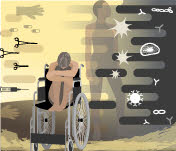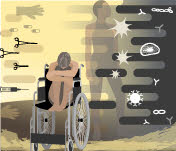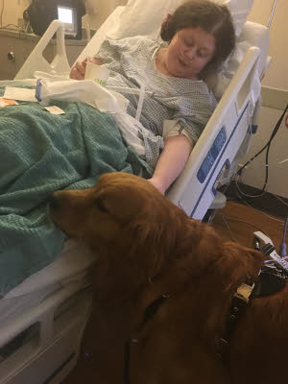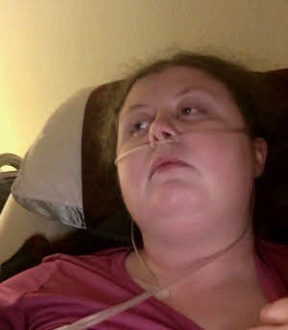
Lessons learned bug

Caroline Mitter was a student at the University of California, Davis, School of Veterinary medicine and a member of the Veterinary Information Network when she was diagnosed in 2014 with a rare chronic disease called mitochondrial cytopathy. The subsequent five years saw her robbed of her ability to finish veterinary school, to walk, to eat, and even to breathe without assistance. However, throughout that time, she trained her own service dog, moderated several Facebook groups and wrote poignantly of life with a chronic illness.
Days before her death in September, Caroline asked a friend to help write a series of essays chronicling lessons learned from her disease. With help from Caroline's father, who was her medical advocate, Christy has drawn from memories and Caroline's own writing to create a four-part commentary. This essay is part of that series.
"I don't really want to leave this planet yet, but it is becoming uninhabitable for me."
– Caroline Mitter, June 5, 2019
Caroline with Cricket 288

Photo courtesy of the Mitter family
An essential member of her support crew, Cricket is shown with Caroline in the hospital in March, six months before Caroline died.
Pain is as consistent and commonplace as death. With a few physiological exceptions, pain is the price of inhabiting a mortal body.
One might think we'd be better at it by now — as a species, as societies and certainly as healers.
At the time I met her, when she was three-quarters of the way through veterinary school, Caroline didn't want to die. She'd been through periods of depression and anxiety for most of her life and had been suicidal at times, but in one of those knife-twists of fate, by the time her body turned against her, her mind was, for the most part, quite keen on living.
Both the medical and legal systems seemed determined to make that living a challenge.
Stanford Hospital, February 2017
Muscles and intestines so clenched in pain she could barely speak, Caroline looked up from her bed at the hospital palliative care team. The duo, consisting of a doctor (whose bowl-cut black hair reminded me of someone beamed directly from a Romulan spaceship) and a young intern or resident, clutched their clipboards to white-coated chests.
"It says here you wanted to talk about pain management," said the Romulan.
Caroline, wiped out from the replacement of yet another central intravenous line, said she would like to discuss a better plan for pain management at home since her intestines were no longer well absorbing the medications given through her G-J (gastrostomy-jejunostomy) tube.
The Romulan pointed out that Caroline’s prescriptions were already for high doses.
Caroline pointed to the drainage from her tube and the inability of her body to process most things given through the gastrointestinal system.
The Romulan expressed concerns about giving too many IV medications at home and the risk of sepsis.
Caroline’s last line had been replaced due to infection from a nurse breaking sterile protocols in the hospital.
The Romulan finally said, "Well, we don’t want you becoming addicted to opioids. We’d like to see you work on other ways to manage your pain."
Yes, there it was: addiction — the great bogeyman of modern medicine — terrifying, except when it isn't.
University of California, Davis, Medical Center trauma ER, circa 2008
Fluorescent lights and endless strips of dropped ceiling tiles passed overhead. A face framed in overly perky scrubs appeared above me.
"Are you in any pain?"
Dr. Christy Corp-Minamiji 288

VIN News Service photo
The author, Dr. Christy Corp-Minamiji, met Caroline in 2014, the year Caroline had intended to join the veterinary profession.
"Well, yes, I got kicked by a horse."
"On a scale of one to 10, with 10 being the worst pain you've ever felt, how would you rate your pain?"
"I dunno, maybe a seven right now?"
The perky face frowned at her clipboard. "OK. I'll have a doctor order something for you right away."
"No, wait. What?"
"Don't you want anything for the pain?"
"Well, maybe some ibuprofen, but you won't give me that because they're worried about internal bleeding, so no, that's OK."
"But you're in pain."
"Well, yes, I got kicked by a horse. But it'll go away and in the meantime, this is my body's way of telling me not to do anything stupid."
That conversation or a similar variant was repeated with tedious regularity to a wide array of faces and perky scrubs for the 24ish hours of my hospitalization. With each iteration, it was clear that I was failing as a patient by turning down opioids. It didn't matter that a lifetime of horse-induced trauma has left me well able to cope with acute, traumatic pain. It didn't matter that my few experiences with opioids have produced only constipation and vague dissociation with little to no analgesia. No one mentioned addiction even once, and they couldn't wait to relieve what they perceived as my horrible pain.
Trauma-induced acute pain has an obvious backstory and is therefore honorable pain. We do love our battle wounds, after all.
Having test-driven a number of pain mechanisms — blunt force, lacerations, dental pain, childbirth, migraines, gastrointestinal dysfunction, etc. — I'm firmly in favor of acute pain. You can breathe through hitting your thumb with a hammer or getting kicked in the face by a calf.
Chronic, visceral pain is a whole different animal.
Chronic pain starts deep within the body and with little notice. It sends all manner of emergency signals to a brain unable to pinpoint the cause of the distress. And it goes on. And on. And on. It's like being hit with the hammer but you can't see or identify your attacker and they won't stop hitting.
According to the U.S. Centers for Disease Control and Prevention, roughly 20% of adults in the United States experience chronic pain. It is correlated with major depressive disorder, job loss, suicidal ideation and impacts on family, friends and society as a whole.
Caroline didn't want to die, but the planet had become uninhabitable.
May 14, 2019, Facebook chat
Caroline: I'm feeling pretty fucking hopeless about finding a new doctor to do my pain management in time. ... They consider it "suspicious" that I "manipulate" my J tube to let it drain so that I won't need as much in the way of pain and nausea meds
Christy: Huh???? So, using techniques to decrease your need for meds means you are seeking meds?.?
Caroline: Anything that is out of the ordinary or that doesn’t make sense to them — to people who have never even met me or any other mito patients — is suspicious
And I honestly don’t know how much longer I can fight it.
We were never exactly sure what the doctors envisioned when they raised the specter of addiction with Caroline. By the time her pain was intractable enough to require frequent, high opioid doses, she was in multi-systemic failure — on a ventilator for respiratory assistance, a G-J tube in place for drainage to help with severe gastrointestinal dysmotility, unable to walk more than a few feet without a walker or power chair except on a very good day, and on total parenteral (intravenous) nutrition. In short, addiction was unlikely to rob her of any measurable quality of life.
But, what about the impacts on society?
What indeed? Caroline and I joked about the physicians picturing her knocking over pharmacies in her power chair assisted by her faithful masked golden retriever.
One doctor said something about not wanting her to be unable to work.
Unable to work? We spent that week trying to figure out how that particular physician set the bar for permanent disability if she didn't qualify in his eyes.
Ultimately, the war on drugs went beyond even pain medication to a concerted effort to deny Caroline, and her non-functioning GI tract, any IV medications including those to stop the massive itching caused by her body's mast cells (immune cells) running amok.
Caroline mast flare 288

Photo courtesy of the Mitter family
Mast flares caused Caroline intense itching and pronounced flushing.
Her mast cell flares had gotten so bad that she scratched in her sleep, excoriating her skin, and in a couple of cases, dislodging her precious central IV line. During a flare, her face and neck grew noticeably flushed and breathing became difficult. Yet, her doctor refused to prescribe an IV antihistamine, suggesting instead that she go to the ER if needed — for flares that were happening multiple times per week.
April 17, 2019, Facebook chat
Christy: Has anyone explained why IV Benadryl is dangerous other than [that your body can actually absorb it]?
Caroline: It could have magical interactions with the opiates, benzos, and other drugs, causing oversedation or cardiac arrhythmias that haven’t happened despite being given IV everything for weeks in the hospital
Christy: Again, how would oral Benadryl not have the same magical interactions, other than, right, it never makes it into your bloodstream. ... They must have had significantly different pharmacology classes from the ones I took
Caroline: Yep, it's so frustrating that I started to cry in the appointment and I actually told her that some doctors seemed to care more about themselves than the patient ...
Christy: It's just so weird. I would never have picked Benadryl as the line in the sand
But it and other IV medications were, in fact, the line in the sand. Despite the fact that Caroline’s body didn't absorb oral medications well, making her need much higher doses than she would if the drugs were given intravenously, her physicians claimed any IV medication — opioid or not — was "too risky for home use," even though she'd been on IV fluids and nutrition for years, and had been intermittently prescribed the very drugs they worried about.
Ultimately, the repeated trauma to her central line caused it to need replacing several times within a few months. Each procedure took more out of her, and each line disruption left her open to infection.
Sepsis from a line infection finally killed Caroline — not because it couldn't be treated but because the only antibiotic to treat it produced massive and immediate vomiting and diarrhea, and because she couldn't see any way forward beyond the cycle of pain, itching, infection and exhaustion.
Pain kills.
Next: Don’t treat people like obstacles
About the author: Dr. Christy Corp-Minamiji is a 1996 graduate of the University of California, Davis, School of Veterinary Medicine. She has practiced small animal medicine and large animal medicine, and worked in the biologics industry. Since 2011, she's worked for the Veterinary Information Network, in communications. Christy and Caroline became friends in 2014. Over the years of their friendship, they shared cupcakes and tea, tears and bad puns, and lots and lots of golden retriever hair. Christy wrote this commentary to honor one of Caroline's final wishes.